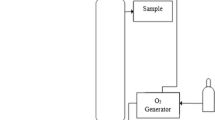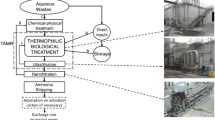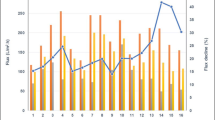Abstract
The aim of this study is to analyze the performances of an integrated homogeneous Sono-Fenton-ultrafiltration process for the removal of 4-chlorophenol from wastewaters both from technical performance (expressed as phenolics concentration and chemical oxygen demand, COD, reduction) and energy consumption point of view, based on simulations using Aspen Plus® software. Based on experimental data (described in Cailean et al. 2014: “Integrated Sono-Fenton Ultrafiltration Process for 4-Chlorophenol Removal from Aqueous Effluents: Assessment of Operational Parameters (Part 1)”) and statistical multi-regression models developed in MATLAB, a simulation model was implemented in Aspen Plus® and developed to calculate mass and energy balances. This model was used to assess the system behavior under various initial settings and process configurations. The effluent type, the presence of additional membrane units (ultrafiltration) and the variation of concentrate recirculation fractions were investigated. The results show that the integrated process registers over 90 % removal efficiency in the permeate of ultrafiltration and reduces between 70 and 90 % of the pollution load in the concentrate, expressed as phenolics concentration, depending on the scenarios analyzed. Recommendations concerning the use of recirculation options and suitable recirculation fractions of the concentrate are indicated, considering the quality of the resulting permeate and concentrate as well as the energy consumption.










Similar content being viewed by others
Abbreviations
- 4CP:
-
4-Chlorophenol
- 4CLCAT:
-
4-Chlorocatechol
- Concentrate 1:
-
The concentrate stream resulting from the ultrafiltration unit, placed before the homogeneous Sono-Fenton stage
- Concentrate 2:
-
The concentrate stream resulting from the ultrafiltration unit, placed after the homogeneous Sono-Fenton stage
- Concentrate recycling:
-
The fraction of the final concentrate stream that is recirculated
- Influent:
-
The initial stream that undergoes treatment
- Permeate 1:
-
The permeate stream resulting from the ultrafiltration unit, placed upstream the homogeneous Sono-Fenton stage
- Permeate 2:
-
The permeate stream resulting from the ultrafiltration unit, placed downstream the homogeneous Sono-Fenton stage
- Recycling:
-
The fraction of the final concentrate stream that is recirculated, from which 4-chlrocatechol is partially bypassed
- UF:
-
Ultrafiltration process
- US:
-
Homogeneous Sono-Fenton process
- US effluent:
-
The stream resulting after the homogeneous Sono-Fenton process
References
Abbasi M, Razzaghi Asl N (2008) Sonochemical degradation of Basic Blue 41 dye assisted by nanoTiO2 and H2O2. J Haz Mater 153:942–947
Bae HS, Lee JM, Kim YB, Lee ST (1996) Biodegradation of the mixtures of 4-chlorophenol and phenol by Comamonas testosterone CPW301. Biodegradation 7:464–469
Barjoveanu G, Teodosiu C (2010) Modeling and simulation of an ultrafiltration process for the removal of suspended solids and colloids from wastewaters. Env Eng Manag 9:361–371
Cailean D (2011) Studies regarding advanced wastewater treatment using ultrasonication and ultrafiltration as combined processes (Studii privind epurarea avansata a apelor uzate prin procese combinate de ultrasonare si ultrafiltrare). PhD Thesis, Politehnium Publishing House, ISBN 978-973-621-346-5, 282 pp
Cailean D, Teodosiu C, Friedl A (2014) Integrated Sono-fenton ultrafiltration process for 4-chlorophenol removal from aqueous effluents: assessment of operational parameters (Part 1). Clean Techn. Environ. Policy. doi:10.1007/s10098-014-0723-x
De Visscher A, Van Eenoo P, Drijvers D, Langenhove HV (1996) Kinetic model for the sonochemical degradation of monocyclic aromatic compounds in aqueous solution. J Phys Chem 100:11636–11642
Delgado S, Diaz F, Vera L, Diaz R, Elmaleh S (2004) Modelling hollow-fibre ultrafiltration of biologically treated wastewater with and without gas-sparging. J Membr Sci 228:55–63
Elghniji K, Hentati O, Mlaik N, Mahfoudh A, Ksibi M (2012) Photocatalytic degradation of 4CP under P-modified TiO2/UV system: kinetics, intermediates, phytotoxicity and acute toxicity. J Environ Sci 24:479–487
El-Sayed W, Ismaeil M, El-Beih F (2009) Isolation of 4-chlorophenol-degrading bacteria, Bacillus subtilis OS1 and Alcaligenes sp. OS2 from petroleum oil-contaminated soil and characterization of its catabolic pathway. Aust J Basic Appl Sci 3:776–783
Farrel A, Quilty B (2002) Substrate dependent autoaggregation of Pseudomonas putida CP1 during the degradation of monochlrophenols and phenol. J Ind Microbiol Biotechnol 28:316–324
Foglia D, Ljunggren M, Wukovits W, Friedl A, Zacchi G, Urbaniec K, Markowski M (2010) Integration studies on a two-stage fermentation process for the production of biohydrogen. J Clean Prod 18:S70–S80
Foglia D, Wukovits W, Friedl A, Ljunggren M, Zacchi G, Urbaniec K, Markowski M (2011) Effects of feedstocks on the process integration of biohydrogen production. Clean Technol Environ Policy 13:547–558
Friedler F (2010) Process integration, modeling and optimization for energy saving and pollution reduction. Appl Therm Eng 30:2270–2280
Goel M, Hongqiang H, Mujumdar AS, Bhowmick Ray M (2004) Sonochemical decomposition of volatile and non-volatile organic compounds: a comparative study. Water Res 38:4247–4261
Klemes JJ, Varbanov PS (2013) Process intensification and integration: an assessment. Clean Technol Environ Policy 15:417–422
Li M, Li JT, Sun HW (2004) Sonochemical decolorization of acid black 210 in the presence of expholiated graphite. Ultrason Sonochem 15:37–42
Linnhoff B, Townsend DW, Boland D, Hewitt GF, Thomas BEA, Guy AR, Marsland RH (1994) A user guide to process integration for the efficient use of energy, last edition. IChemE, Rugby
Michalowicz J (2005) The occurrence of chlorophenol, chlorocatechols and chlorinated methoxyphenols in drinking water of the largest cities in Poland. Polish J Environ Stud 14:327–333
Miltner A, Wukovits W, Proll T, Friedl A (2010) Renewable hydrogen production: a technical evaluation based on process simulation. J Clean Prod 18:S51–S62
Modarresi A, Wukovits W, Foglia D, Friedl A (2010) Effect of process integration on the exergy balance of a two-stage process for fermentative hydrogen production. J Clean Prod 18:S63–S71
Mohammadi T, Kohpeyma A, Sadrzadeh M (2005) Mathematical modeling of flux decline in ultrafiltration. Desalination 184:367–375
Murcia MD, Gomez M, Gomez E, Gomez JL, Christofi N (2009) Comparison of different AOPs for degrading 4-chlorophenol. World Acad Sci Eng Technol 55:249–253
Sayan E, Esra Edecan M (2008) An optimization study using response surface methods on the decolorization of reactive blue 19 from aqueous solution by ultrasound. Ultrason Sonochem 15:530–538
Seferlis P, Dalaouti N, Kenig EY, Huepen B et al (2005) Modelling and optimization of industrial absorption processes: an EC collaborative research project. Comput Aided Chem Eng 20:1525–1530
Serpone N, Terzian R, Hidaka H, Pellizzeti E (1994) Ultrasonic induced dehalogenation and oxidation of 2-,3-, and 4-chlorophenol in air equilibrated aqueous media. Similarities with irradiated semiconductor particulates. J Phys Chem 98:2634–2640
Sivasankar T, Moholkar VS (2008) Physical features of sonochemical degradation of nitroaromatic pollutants. Chemosphere 72:1795–1806
Sivasankar T, Moholkar VS (2009) Mechanistic approach to intensification of sonochemical degradation of phenol. Chem Eng J 149:57–69
Soleimani R, Shoushtari NA, Behrooz M, Salahi A (2013) Experimental investigation, modeling and optimization of membrane separation using artificial neural network and multi-objective optimization using genetic algorithms. Chem Eng Res Des, 91:883-903
Teodosiu C, Pastravanu O, Macoveanu M (2000) Neural network models for ultrafiltration and backwashing. Water Res 34:4371–4380
Teodosiu C, Manea LR, Barjoveanu G, Bertea A, Musteret CP, Cailean D (2010) Integrated ultrafiltration–ultrasonication process for textile effluents treatment. Romanian Patent no. 122813
Thevendiraraj S, Klemes J, Paz D, Aso G, Cardenas GJ (2003) Water and wastewater minimisation study of a citrus plant. Resour Conserv Recycl 37:227–250
van Iersel MM (2008) Sensible sonochemistry, Doctoral Thesis. Technical University of Eindhoven, Eindhoven
Wang YP, Smith R (1994) Wastewater minimisation. Chem Eng Sci 49:981–1006
Yuliwati E, Ismail AF, Lau WJ, Ng BC, Mataram A, Kassim MA (2012) Effects of process conditions in submerged ultrafiltration for refinery wastewater treatment: optimization of operating process by response surface methodology. Desalination 287:350–361
Zhang H, Zhang J, Zhang C, Liu F, Zhang D (2009) Degradation of C.I. Acid Orange 7 by the advanced fenton process in combination with ultrasonic irradiation. Ultrason Sonochem 16:325–330
Acknowledgements
This study was supported by the Romanian National Authority for Scientific Research, CNDI– UEFISCDI, Project no. 60/2012 (PNII Parteneriate), “Integrated System for Reducing Environmental and Human-related Impacts and Risks in the Water Use Cycle” (WATUSER) and BRAIN project “Doctoral scholarships as an investment in intelligence” (ID-6681), financed by the European Social Fund and the Romanian Government.
Author information
Authors and Affiliations
Corresponding author
Rights and permissions
About this article
Cite this article
Cailean, D., Wukovits, W., Teodosiu, C. et al. Integrated Sono-Fenton ultrafiltration process for 4-chlorophenol removal from aqueous effluents: process modeling and simulation Part 2. Clean Techn Environ Policy 16, 1161–1177 (2014). https://doi.org/10.1007/s10098-014-0716-9
Received:
Accepted:
Published:
Issue Date:
DOI: https://doi.org/10.1007/s10098-014-0716-9




